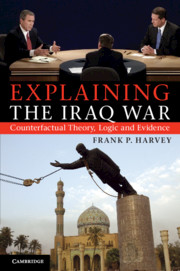Book contents
- Frontmatter
- Contents
- Figures
- Tables
- Acknowledgments
- Introduction
- 1 Comparative counterfactual analysis and the 2003 Iraq war
- 2 Leadership, political context(s) and the Iraq war
- 3 Democratic national security advisers
- 4 Domestic and congressional politics
- 5 American intelligence failures and miscalculations
- 6 Societal pressures and public opinion
- 7 International politics, global WMD consensus and UN power balancing
- 8 Hussein’s mistakes, miscalculations and misperceptions
- 9 Summary and implications
- 10 Conclusion
- Bibliography
- Index
6 - Societal pressures and public opinion
Published online by Cambridge University Press: 05 June 2012
- Frontmatter
- Contents
- Figures
- Tables
- Acknowledgments
- Introduction
- 1 Comparative counterfactual analysis and the 2003 Iraq war
- 2 Leadership, political context(s) and the Iraq war
- 3 Democratic national security advisers
- 4 Domestic and congressional politics
- 5 American intelligence failures and miscalculations
- 6 Societal pressures and public opinion
- 7 International politics, global WMD consensus and UN power balancing
- 8 Hussein’s mistakes, miscalculations and misperceptions
- 9 Summary and implications
- 10 Conclusion
- Bibliography
- Index
Summary
The preceding four chapters have outlined the leadership, domestic political and organizational factors that privileged some options over others and combined to reinforce the utility of key decisions on the path to war. But there are several societal and international (Chapter 7) pressures that should also be considered when evaluating the relative strengths of Gore-war and Gore-peace counterfactuals. Of course, these ‘structural’ variables, like the organizational impediments described in the previous chapter, are less amenable to significant alterations over time and, by extension, are much more likely to encourage continuity across administrations. The broader the level of analysis, the more structured the variables, and the more likely they are to induce consistent priorities and patterned behavior from one leader to the next.
For example, polling on public approval of Bush’s Iraq strategy from 2002 to 2003 was consistently above 60 percent, the highest polling numbers since the peak after 9/11 (see Figure 6.1).
- Type
- Chapter
- Information
- Explaining the Iraq WarCounterfactual Theory, Logic and Evidence, pp. 181 - 194Publisher: Cambridge University PressPrint publication year: 2011

